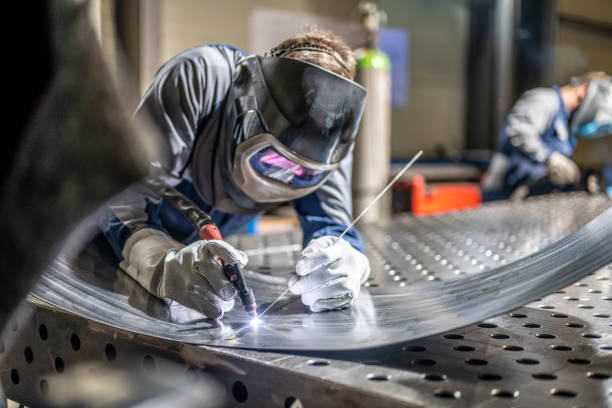Welding thin sheet metal (for example, steel or aluminium in gauges typical of ductwork, panels, enclosures) presents unique challenges. Ensuring good weld fusion without burn-through, distortion or weak joints demands special technique, equipment settings, and process control. This article walks you through practical guidance for successful welding of thin gauge materials, aimed at engineers, fabricators and maintenance professionals seeking reliable results.

1. Why Welding Thin Gauge Sheet Metal Is Different - Challenges
Welding thin materials (often 24 gauge (0.6 mm) to about 10–11 gauge (3–3.5 mm)) involves a delicate balance: you must deliver enough heat and fuse the joint adequately, yet avoid too much heat input that causes burn-through, warping, excessive heat-affected zone (HAZ) or risk of weak welds. (See guidance about minimizing burn-through and distortion when welding thin-gauge materials.) Some of the key issues include:
Burn-through: The material is so thin that too much heat causes the metal to melt through, leaving holes.
Distortion / warping: Thin sheet expands and contracts quickly under heat, so improper heat management means panels twist or change shape.
Excessive HAZ: The heat‐affected zone may degrade the material’s mechanical or corrosion properties, particularly for alloys.
Fusion issues: Because the weld pool must be very controlled, insufficient penetration or poor fusion is a risk, especially with gaps or poor fit-up.
Fit-up sensitivity: Thin metal demands close tolerances, minimal gaps, and clean surfaces to avoid defects.
Understanding these constraints helps you make informed decisions on process, settings and technique.
2. Process- and equipment-selection fundamentals
Selecting the right welding process and equipment setup is a foundational step. Key points:
2.1 Select the Ideal Welding Process
The choice of welding method is one of the most critical factors in welding thin gauge sheet metal:
1) TIG Welding (Gas Tungsten Arc Welding)
Offers precise control over heat with independent electrode and filler rods
Produces clean, high-quality welds ideal for very thin or stainless steel sheets
Best for projects where appearance and minimal distortion are priorities
2) MIG Welding (Gas Metal Arc Welding)
Faster and easier for thin metals, especially with smaller diameter wire (e.g., .023")
Pulsed MIG welding technology can greatly reduce heat input and spatter
Popular for automotive and production environments, balancing speed and quality
3) Spot Welding
4) Laser Welding (Advanced)
Offers ultra-precise, minimal heat input welds with almost no distortion
Typically requires expensive equipment, ideal for specialized industrial use
2.2 Welding Equipment & consumables
Use the smallest electrode or wire diameter that still meets fusion requirements. Smaller wires melt more easily and reduce heat input.
Set amperage and voltage low enough to avoid burning through, yet high enough to maintain good fusion and bead shape. That often means faster travel speeds, minimal arc length, and avoiding wide weaving.
The torch/gun angle and travel speed matter: pushing the torch (for MIG) is often preferred for heat control; travel speed should be as fast as possible while maintaining sound weld.
Use shielding gas suited for thin work (for example a high proportion of argon for MIG on thin steel to reduce heat input and spatter) or appropriate argon/helium for aluminium.
2.3 Joint design, fit-up and backing
Ensure tight and clean fit-up: even a small gap on thin material may lead to burn through or weak welds.
For thin sheets susceptible to distortion, use tack welding or intermittent/skip welding to distribute heat and allow cooling between welds rather than continuous long beads.
Use a backing bar (e.g., copper, aluminium) or conductive clamp on the underside of the joint to draw away heat and support the weld pool, reducing warping and burn-through risk.
3. Technique tips & strategies for thin-sheet welding
Here are practical technique suggestions to apply when working with thin gauge sheet metal.
3.1 Control the heat input
Short welds or “stitch” style welding: Rather than a continuous weld bead, apply short weld segments spaced along the joint, allowing material between bursts to cool. This helps avoid overheating.
Use fast travel speed, minimal weaving, and short arc length. The longer the arc stays in one spot, the higher the risk of burn through or distortion.
Keep amperage and voltage as low as feasible. One guideline for TIG welding thin gauge: around 1 Amp per 0.001″ (or similar) of material thickness—while recognizing the formula falls off at thicker gauges.
3.2 Use appropriate wire / electrode and filler
For MIG on thin steel, wires like .023-inch (0.6 mm) diameter are commonly used until ~18-gauge, stepping up perhaps to .030-inch for thicker thin-sheet work.
For TIG, use a small diameter tungsten electrode (e.g., 1/16″ or less) that works at low amperage, pointed and properly prepared, to focus the arc.
Matching filler metal to base material and thickness is still required: using a filler that is too massive will require too much heat and risk damaging the thin base plate.
3.3 Use skip/tack welding to manage heat build-up
Tack weld at intervals across the joint and allow the sheet to cool between tack sections. This breaks up heat accumulation.
With skip/stitch welding, alternate weld segments along the joint (for example weld near one end, then move to the other end, then return) to spread heat away from one locale.
3.4 Use backing bars and fixturing
A backing clamp made of a high-conductivity material (copper or aluminium) placed against the underside of the thin sheet helps draw heat away from the weld zone, reducing warpage and burn-through.
Good fixturing to hold parts tightly and minimize gaps prevents heat concentration and movement due to thermal expansion/contraction.
3.5 Travel angle, technique and gun orientation
For MIG, pushing the torch (i.e., gun pointed slightly forward in direction of travel) helps point the arc away from the hot puddle and reduces heat concentration.
Avoid wide torch weaving or drag-style heavy side-to-side motion; such motion increases time per area and heat input. For thin sheet, simpler straight travel is better.
3.6 Cleanliness and surface preparation
As with all welding, but even more critical in thin gauge work, ensure surfaces are free of dirt, oil, paint, rust, and contamination. Poor cleaning can increase heat required for fusion and increase risk of defects.
Remove edge bevels, burrs or gaps that invite burn-through. Fit-up should be as tight as possible.
4. Material-specific considerations
While much of the advice above applies broadly, it’s useful to highlight a few material‐specific points common in thin-gauge applications (steel, stainless, aluminium).
4.1 Thin steel sheet
For mild or plain carbon steel sheet, wire diameters like .023″ or .030″ in MIG short-circuit mode are typical, with a high-argon shielding gas (e.g., 75% Ar / 25% CO₂) to limit heat and spatter.
Spot welding or intermittent welding may also be practical in high-volume panel production.
4.2 Thin stainless steel sheet
Stainless sheet behaves similarly to steel for thin gauge welding. Pulsed modes can help give more control.
Match filler alloys (e.g., 304 → 308 filler) and ensure shielding gas mixtures suit stainless.
4.3 Thin aluminium sheet
Aluminium presents extra challenges due to high thermal conductivity, oxide layer and low melting point when thin. Heat control is even more acute.
If using TIG on thin aluminium, choose appropriately low amperage, smaller tungsten electrode, and consider AC mode if cleaning oxide simultaneously.
5. Common defects and how to avoid them
Here are some of the most frequent issues when welding thin sheet metal, and what you can do to correct/avoid them.
| Defect | Cause | Mitigation |
|---|
| Burn-through/holes | Excess heat input, long weld segments, large wire | Reduce wire diameter, shorten weld segments, increase travel speed, use stitch pattern |
| Distortion/warping | Heat accumulation, uneven cooling, wide welds | Use backing bars/fixturing, use tack or intermittent welds, minimise heat, clamp sheet |
| Lack of fusion / weak welds | Low heat, poor fit-up, contaminants | Ensure proper cleaning, assure tight fit, maintain correct parameters, use suitable filler |
| Rough bead / excessive spatter | Wrong transfer mode, large wire, high heat | Use appropriate transfer mode (short-circuit or pulsed), smaller wire, adjust gas/shielding |
| Large HAZ or material degradation | Excessive heat or slow travel | Reduce amperage, travel faster, use smaller weld bead, fixture to draw away heat |
6. Best practices checklist
Before you strike arc, run through this checklist for thin gauge sheet metal welding:
Confirm sheet thickness, material type (steel, stainless, aluminium) and condition (coatings, rust, paint).
Select wire/electrode diameter minimal for adequate fusion.
Choose weld process and mode (MIG short-circuit or pulsed, TIG) suited for thin sheet.
Ensure tight fit-up and minimal gap. Use backing bar or clamp if needed.
Plan for tack or skip welding rather than long continuous welds.
Set machine parameters: low amperage/voltage, short arc length, push gun angle (for MIG), fast travel speed.
Clean surfaces thoroughly (wipe, brush, degrease).
Monitor travel speed; maintain consistent movement and avoid stopping in one place.
Inspect weld after first pass; check for burn-through, distortion, fusion; adjust if required.
Document settings and approach so you can replicate the process reliably in production or future jobs.
7. Frequently Asked Questions (FAQ)
Q1: Can I weld very thin sheet metal (say 0.8 mm) using standard MIG settings for heavy plate?
A1: No. Heavy-plate settings will almost certainly overheat the thin sheet, leading to burn-through, excessive distortion or weak welds. Thin gauge welding demands much lower heat input, smaller wires, faster travel speeds, and possibly intermittent welds.
Q2: Why does using a smaller wire diameter help on thin sheet metal?
A2: A smaller wire diameter melts using less heat, thereby reducing the amount of heat transferred into the thin base metal. That leads to lower risk of burn-through and distortion while still permitting fusion of the joint.
Q3: What is “skip welding” and why is it used?
A3: Skip (or stitch) welding is the technique of welding short sections of a joint at intervals rather than a continuous weld. This allows the material between welds to cool, reducing heat accumulation and the risk of burn-through or distortion.
Q4: When should I use a backing bar or clamp when welding thin sheet metal?
A4: A backing bar is most useful when the sheet is very thin, likely to warp or blow through, and you can use a conductive metal bar (copper or aluminium) clamped to the backside to absorb heat and support the weld. It helps manage heat dissipation and maintain dimensional stability.
Q5: Is TIG always better than MIG for thin sheet metal?
A5: Not always. TIG provides more precise control over heat, making it advantageous for very thin sheet, high quality welds, or critical joints. However, MIG (especially in short-circuit or pulsed modes) may be faster and more cost-effective in many thin sheet production scenarios provided the technique is controlled properly. The correct choice depends on material, thickness, quality requirement and cost constraints.
Conclusion
Successfully welding thin-gauge sheet metal is less about brute force and more about precision, heat control and fit-up. Use the right process, size your equipment and consumables appropriately, design your joint and fixturing with thermal behavior in mind, and apply controlled technique: short welds, fast travel, minimal heat per unit area, adequate backing or heat sinking. By following structured practices and documenting results, you’ll achieve reliable, repeatable welds in thin sheet applications—whether in sheet-metal fabrication, HVAC, enclosure manufacture or light-duty structural work.
Related articles:
1. How to Weld Thin Metal: Types, Welders, and Techniques (2023)
2. Tips for Setting MIG Welding Parameters for Thin Materials
3. Pulsed TIG Welding — Weld Thin Like a Pro
4. How to TIG Weld Thin Steel Tubing with Precision and Expertise?
5. Everything You Need to Know on Welds, Symbols, and Positions




